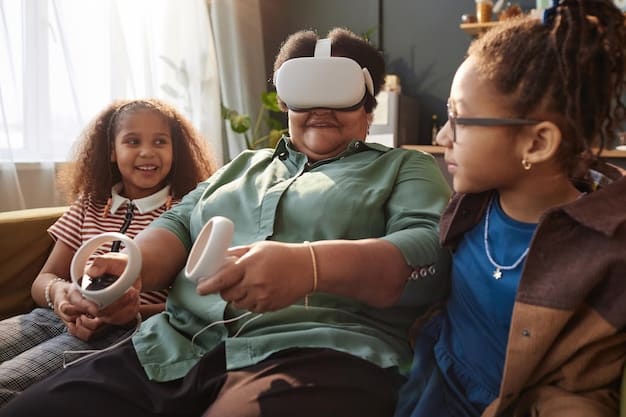PC Gaming Accessibility: Addressing Challenges for Disabled Gamers

PC gaming accessibility focuses on overcoming challenges faced by disabled gamers through hardware, software, and community efforts, ensuring a more inclusive and enjoyable gaming experience for everyone.
The world of PC Gaming’s Accessibility Problem: Addressing Challenges for Disabled Gamers has traditionally presented numerous hurdles for gamers with disabilities. From complex control schemes to visual and auditory impairments, many aspects of PC gaming create barriers that prevent equal participation. However, with increasing awareness, technological advancements, and a growing push for inclusivity, significant strides are being made to address these challenges.
Understanding the Scope of Accessibility in PC Gaming
Addressing accessibility in PC gaming requires a comprehensive understanding of the diverse needs and challenges faced by disabled gamers. This involves recognizing the various types of disabilities that can impact gaming experiences and identifying the specific barriers that prevent full participation.
Accessibility isn’t just about adding a few options to a settings menu; it’s about fundamentally rethinking how games are designed and developed to be inclusive from the ground up.
Types of Disabilities Affecting PC Gaming
Several types of disabilities can significantly impact a player’s ability to enjoy PC games. These include:
- Motor impairments: Conditions like cerebral palsy, muscular dystrophy, or spinal cord injuries can limit a player’s range of motion, dexterity, and coordination.
- Visual impairments: Blindness, low vision, and color blindness can make it difficult or impossible to see on-screen elements, read text, and navigate game interfaces.
- Auditory impairments: Deafness and hearing loss can hinder a player’s ability to hear crucial sound cues, understand dialogue, and fully immerse themselves in the game’s soundscape.
- Cognitive impairments: Conditions like ADHD, autism, or learning disabilities can affect a player’s attention span, memory, and ability to process information.

By understanding the specific needs of different disability groups, developers can create more inclusive games that cater to a wider audience. This not only improves the gaming experience for disabled players but also enhances the overall quality and appeal of the game.
Hardware Solutions for Accessible PC Gaming
One of the most significant areas of progress in PC gaming accessibility is the development of specialized hardware solutions. These devices are designed to overcome physical limitations and provide alternative input methods for gamers with motor impairments.
From adaptive controllers to eye-tracking systems, a wide range of hardware options are now available to help disabled gamers participate in the PC gaming community.
Adaptive Controllers: Redefining Input
Adaptive controllers are modified or custom-built devices that allow gamers with limited mobility to control their games. These controllers can be tailored to individual needs and preferences, offering a range of input options.
For example, the Xbox Adaptive Controller is a modular device that can be connected to a variety of external switches, buttons, and joysticks, allowing users to create a personalized control scheme.
Assistive Peripherals: Enhancing Accessibility
In addition to adaptive controllers, a variety of assistive peripherals can enhance accessibility in PC gaming. These include:
- Foot pedals: Allow gamers to control certain actions with their feet, freeing up their hands for other tasks.
- Head-tracking devices: Enable gamers to control the mouse cursor or camera movement with their head movements.
- Voice-activated software: Allows gamers to issue commands and control in-game actions using their voice.
These hardware solutions represent a significant step forward in making PC gaming more accessible. By providing alternative input methods and customizable control schemes, they empower disabled gamers to participate more fully and enjoyably.
Software and Game Design for Inclusivity
While hardware solutions play a crucial role in PC gaming accessibility, software and game design are equally important. Developers can incorporate accessibility features into their games to make them more inclusive and accommodating for players with disabilities.
These features can range from customizable controls and adjustable difficulty settings to visual and auditory aids that enhance gameplay for those with visual or auditory impairments.
Customizable Controls: Tailoring the Experience
One of the most important accessibility features in PC games is the ability to customize controls. This allows players to remap buttons, adjust sensitivity settings, and create personalized control schemes that suit their individual needs and preferences.
The ability to customize controls is especially important for gamers with motor impairments, who may need to use alternative input methods or remap buttons to accommodate their limited range of motion.
Visual and Auditory Aids: Enhancing Perception
Visual and auditory aids can significantly improve the gaming experience for players with visual or auditory impairments. These aids include:
- Adjustable text size and contrast: Allows players to customize the size and appearance of text in menus, dialogue boxes, and other in-game elements.
- Colorblindness modes: Adjusts the color palette to make it easier for colorblind players to distinguish between different colors.
- Subtitles and closed captions: Provides text-based representations of dialogue, sound effects, and other auditory information.
By incorporating these features into their games, developers can create more inclusive experiences that cater to a wider range of players.
The Role of the Gaming Community
The gaming community plays a vital role in promoting accessibility and inclusivity in PC gaming. By raising awareness, providing support, and advocating for change, gamers can help create a more welcoming and accessible environment for disabled players.
Online communities, forums, and social media groups can serve as valuable resources for disabled gamers, providing a space to connect, share information, and offer mutual support.
Advocacy and Awareness: Driving Change
Gamers can advocate for accessibility by contacting developers, providing feedback, and demanding more inclusive game design. By raising awareness of the challenges faced by disabled gamers, they can encourage the industry to prioritize accessibility.
Organizations like AbleGamers and SpecialEffect play a crucial role in advocating for accessibility and providing resources for disabled gamers. These organizations work with developers, conduct research, and offer training to promote inclusive game design.
Support Networks: Fostering Inclusion
Online communities and support networks provide a valuable space for disabled gamers to connect, share experiences, and offer mutual support. These communities can help combat social isolation and provide a sense of belonging.

By fostering a culture of inclusivity and support, the gaming community can help break down barriers and create a more welcoming environment for disabled players.
Evolving Technologies and the Future of Accessibility
The future of accessibility in PC gaming is closely tied to the development of evolving technologies. Advancements in artificial intelligence, virtual reality, and augmented reality hold the potential to revolutionize the way disabled gamers interact with and experience games.
These technologies can provide new and innovative solutions for overcoming physical limitations, enhancing sensory perception, and creating more immersive and accessible gaming experiences.
AI-Powered Accessibility: Adaptive Assistance
Artificial intelligence (AI) can be used to create adaptive gaming systems that automatically adjust to a player’s individual needs and abilities. AI algorithms can analyze a player’s performance and provide personalized assistance, such as adjusting difficulty levels, providing real-time feedback, or automating complex tasks.
AI-powered accessibility has the potential to transform the gaming experience for disabled players, providing personalized support and ensuring that they can participate fully and enjoyably.
VR and AR: Immersive and Accessible Worlds
Virtual reality (VR) and augmented reality (AR) technologies offer new ways to create immersive and accessible gaming experiences. VR can transport players to virtual worlds, providing them with new ways to interact with and explore game environments.
- Haptic feedback: Provides tactile sensations, allowing players to feel the game world around them.
- Eye-tracking technology: Enables players to control in-game actions with their eye movements.
VR and AR technologies have the potential to create more inclusive and engaging gaming experiences for disabled players, breaking down barriers and opening up new possibilities.
Legal and Ethical Considerations
The push for accessibility in PC gaming also raises important legal and ethical considerations. As awareness of disability rights grows, there is increasing pressure on developers and publishers to ensure that their games are accessible to all players.
This includes complying with accessibility standards, incorporating accessibility features into game design, and providing reasonable accommodations for disabled players.
Accessibility Standards: Ensuring Compliance
Several accessibility standards, such as the Web Content Accessibility Guidelines (WCAG), provide guidelines for making digital content more accessible. While these standards are not always directly applicable to PC games, they can serve as a valuable resource for developers.
- Understanding WCAG: Learning about WCAG principles can help developers implement more inclusive design practices.
- Applying relevant guidelines: Adapting WCAG guidelines to game development can improve accessibility for a wider range of players.
By adhering to accessibility standards, developers can ensure that their games are compliant with legal requirements and ethical considerations.
Ethical Responsibilities: Promoting Inclusion
Beyond legal compliance, developers also have an ethical responsibility to promote inclusion and accessibility in PC gaming. This includes considering the needs of disabled players during the design process, providing accessibility features, and actively seeking feedback from the gaming community.
By embracing ethical practices, developers can create more welcoming and inclusive gaming experiences for all players, regardless of their abilities.
| Key Point | Brief Description |
|---|---|
| 🎮 Adaptive Hardware | Specialized controllers and peripherals for gamers with motor impairments. |
| ⚙️ Software Customization | Adjustable controls, visual aids, and auditory cues for inclusivity. |
| 🤝 Community Support | Online networks and advocacy for disabled gamers. |
| 🤖 AI and VR | Future tech offers personalized assistance and immersive experiences. |
Frequently Asked Questions
PC gaming accessibility involves designing and developing games to be inclusive for players with disabilities, addressing motor, visual, auditory, and cognitive challenges.
Adaptive controllers are modified devices that allow gamers with limited mobility to control games, often customized to suit individual needs and preferences.
Software improvements include customizable controls, adjustable text sizes, colorblindness modes, and subtitles, enhancing the gaming experience for impaired players.
Community support provides a platform for disabled gamers to connect, share experiences, and advocate for more inclusive game design and industry practices.
VR and AI can create immersive and personalized gaming experiences, offering adaptive assistance and new ways to interact with game environments for disabled gamers.
Conclusion
Addressing the PC Gaming’s Accessibility Problem: Addressing Challenges for Disabled Gamers is not just about making games playable for everyone; it’s about enriching the gaming community as a whole. By embracing inclusive design principles and leveraging technological advancements, we can create a more diverse, equitable, and enjoyable gaming landscape for all. The journey towards full accessibility is ongoing, but with continued effort and advocacy, the future of PC gaming promises to be one where everyone can play and participate.





